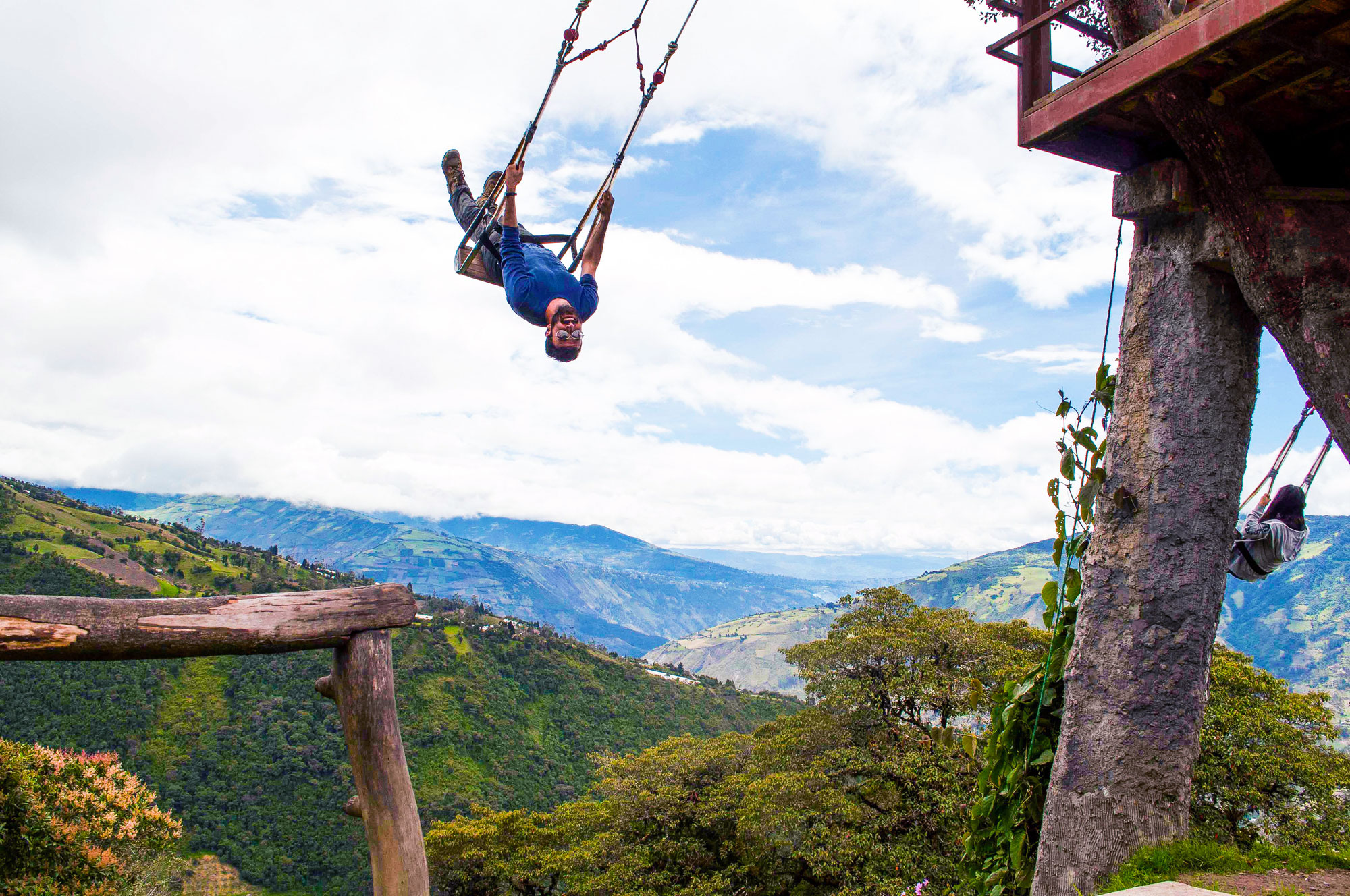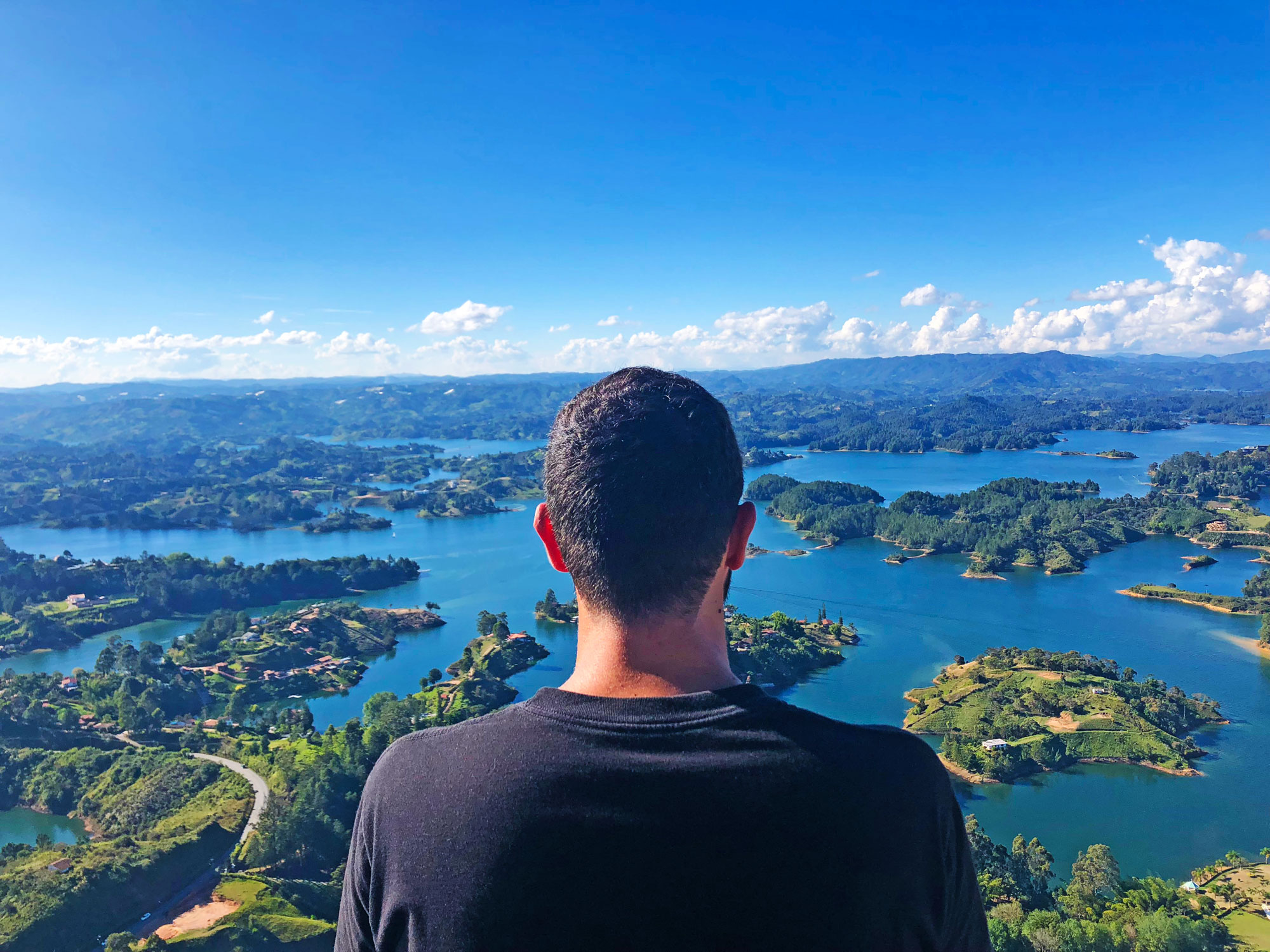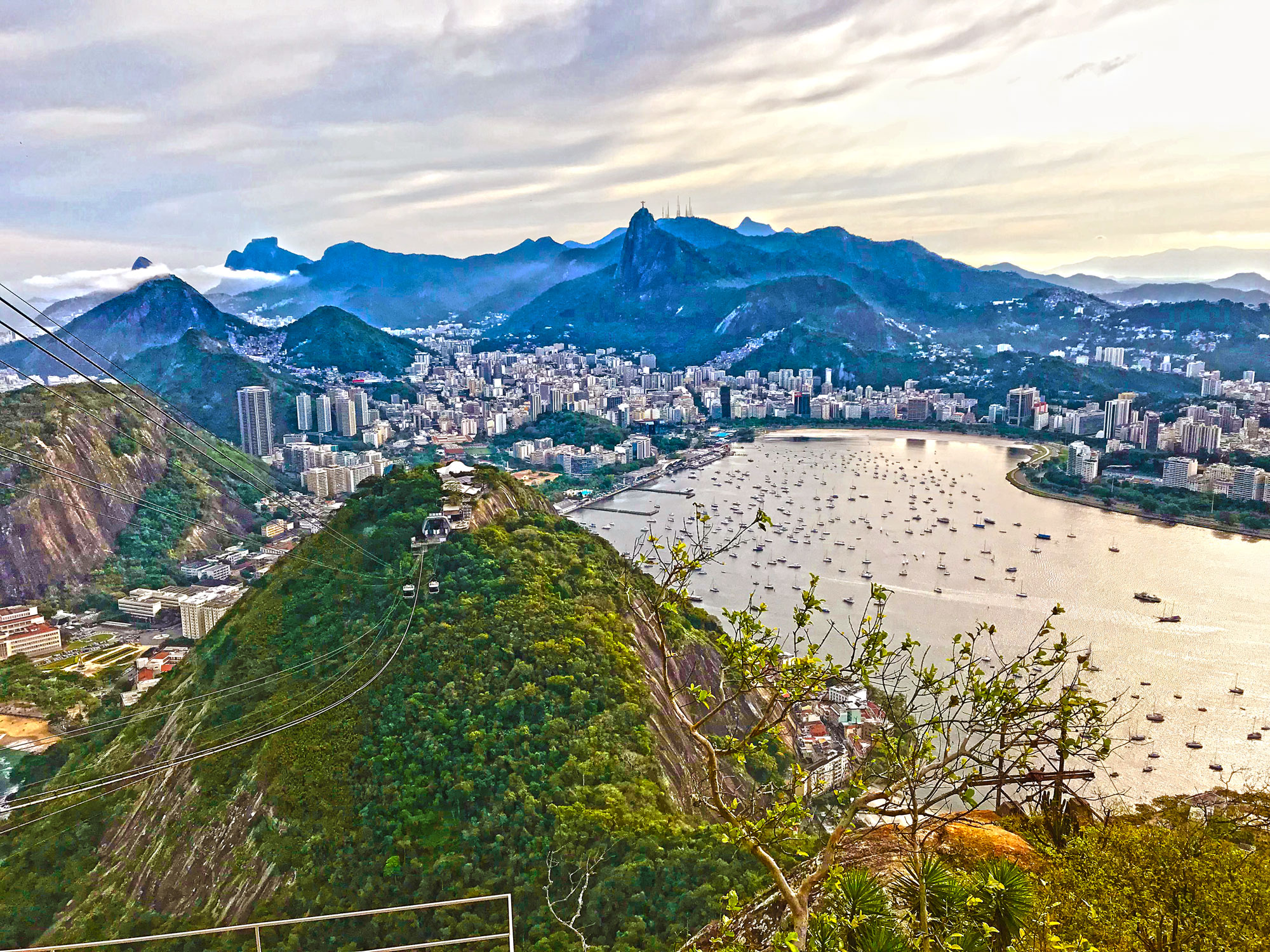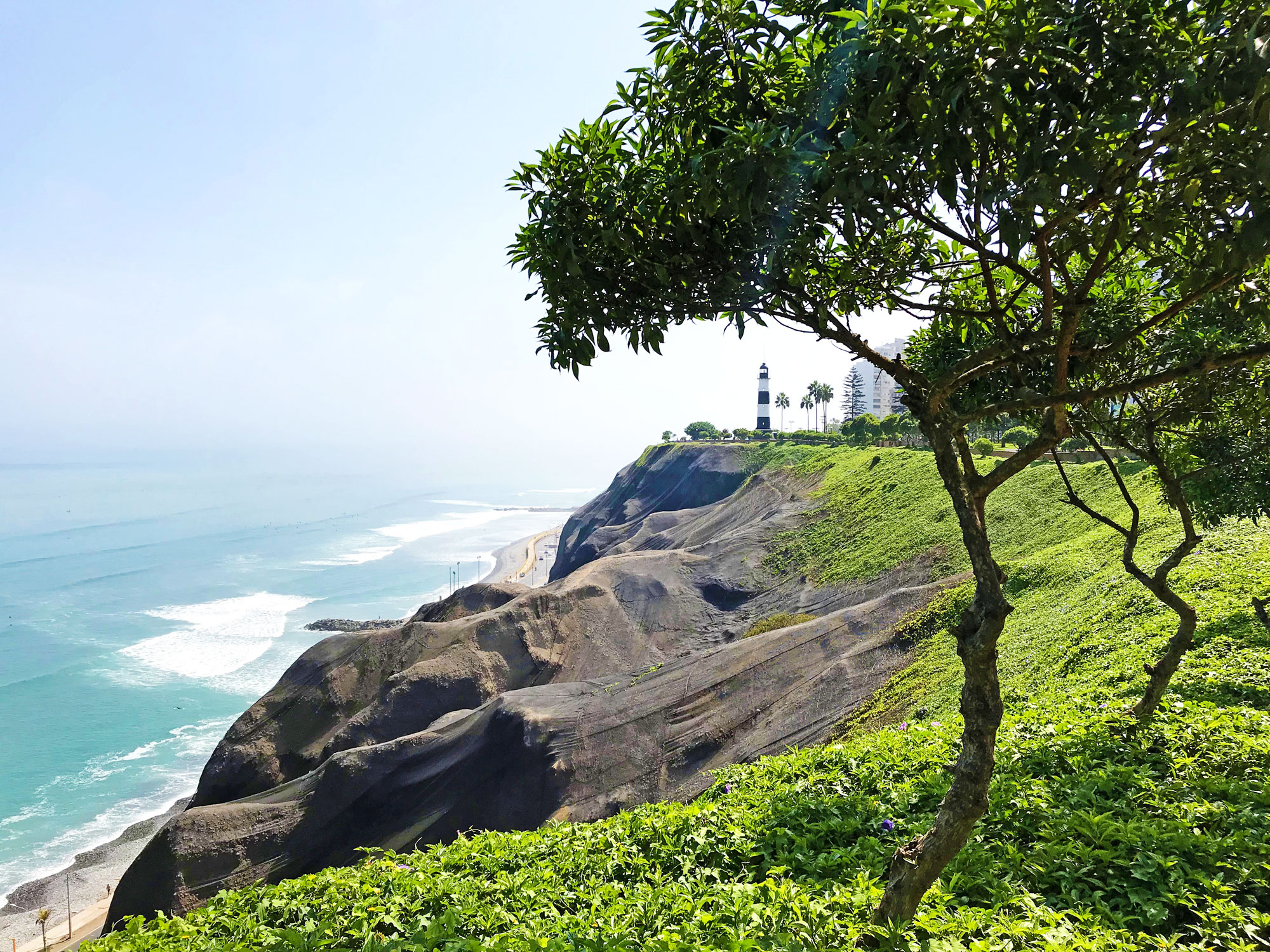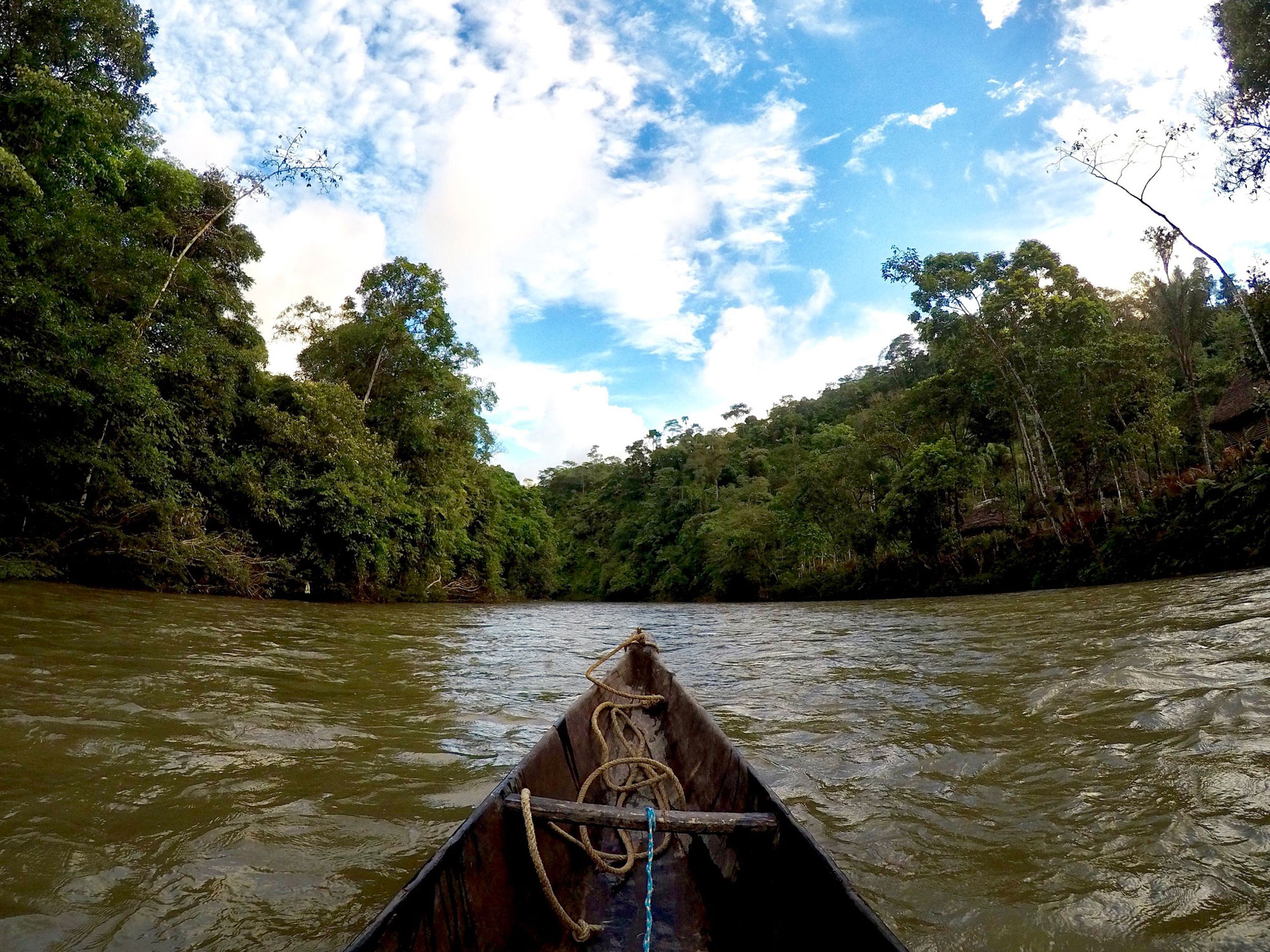I have lived in Quito for the last month: the first “chapter” of my digital nomad experience with WifiTribe was great! I’m already in Lima while writing, as it has been a month so full that it has been hard to find the time to write. But here I am and here are some thoughts about the Ecuadorian capital.
WifiTribe
In this chapter, we were 16 people from all over the World: Italy (me!), Nederlands, Denmark, Sweden, Bolivia, Germany, Canada and US.
Each one with his own job: designers, developers, project managers, entrepreneurs, online poker players… We used to work hard during the week, from cafes or from common areas in the house, and party hard during the weekend!
The house was an entire hostel just for us and we were split into different rooms for one to two people each, on different floors. A very nice environment actually, with a yard and a big terrace where to party or work from.

Working from the terrace
Being in the same house, it was easy to stay with other people, eat together, sometimes cook together and (especially!) drink together. The only downside was the neighborhood: there weren’t nice places where to eat or hang out and for going anywhere we had to get a taxi.
Anyway, I really enjoyed the people and I made good connections with most of them, even though my English is not perfect and sometimes it was hard to understand Americans speaking too fast or mumbling.
The city
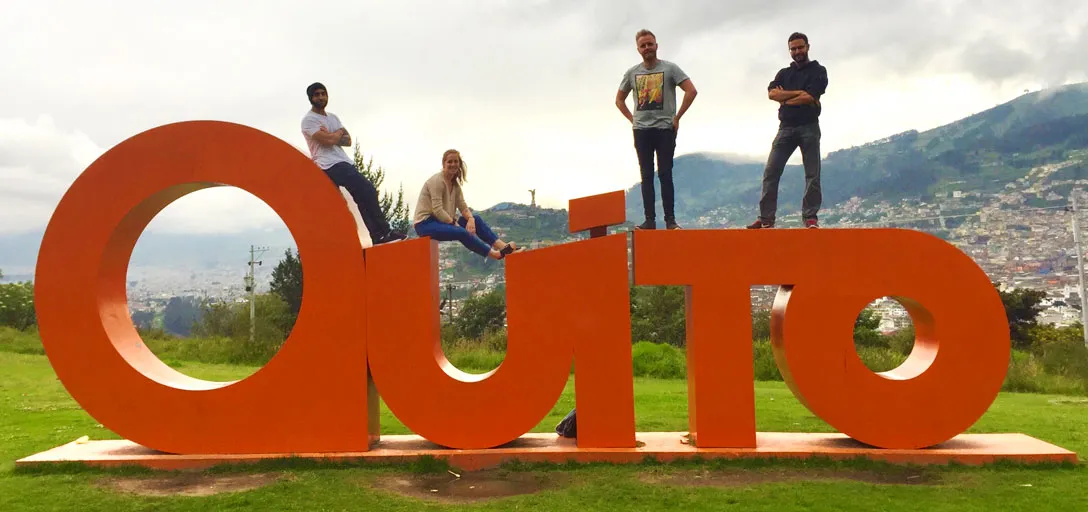
Quito with my new friends
I still don’t know if I like Quito. I mean, it’s geographically interesting, located among mountains and volcanos at an elevation of 2,800 meters above sea level. If you have the chance to see it from above, it’s a breathtaking view: the city extends for about 40 km and it follows the valley’s and mountains’ shape, creating so many ups and downs.
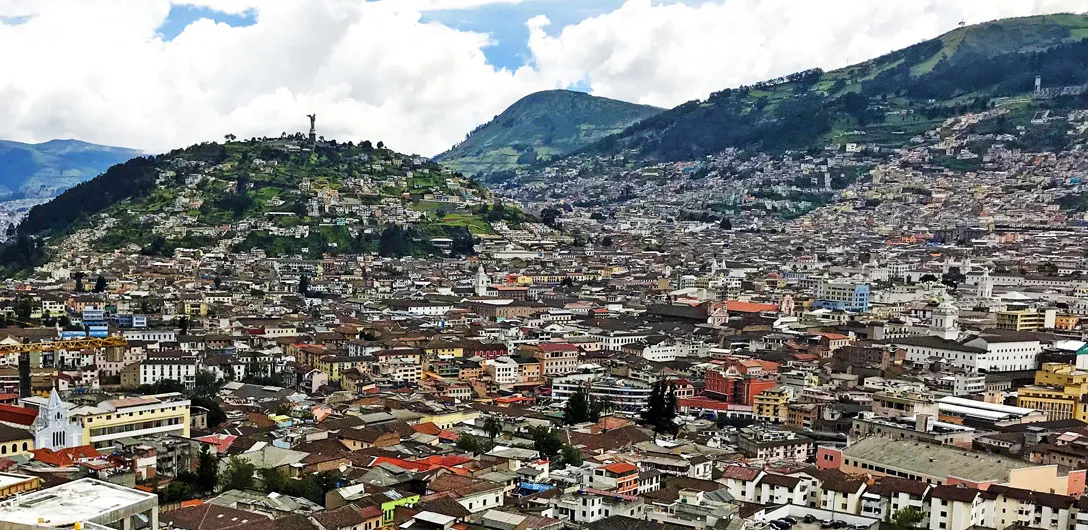
The stunning view of Quito from above
Moreover, it’s a city full of culture and history: in 1978 Quito was declared a UNESCO World Heritage Site for having the best-preserved, least altered historic center in Latin America.
Even so, Quito has so many problems. Firstly it’s dirty and polluted. It’s not really a pleasure walking in the streets, while every few minutes a bus passes by you, leaving a dark stinky cloud behind. The roads are bumpy, full of trash and you have to be careful not to step on a dog’s poop. Yes, Quito is the city of stray dogs: you see them crossing the street carelessly, alone or in packs. So it’s normal that you find also their droppings.
My favorite area is the historic center, although it’s quite chaotic: you meet street hawkers everywhere (also kids!), trying to sell you any kind of street food. And there are hookers in every corner, also during the day… If you see a woman standing on a crossroad, there’s a high chance she is a prostitute, even if she’s not dressed up with flashy clothes.
Exploring Quito can also be quite challenging, because there are so many uphill roads: you have to climb hills, slopes and stairs. And I assure you that you feel the altitude. Every. Single. Step. Even after a month.
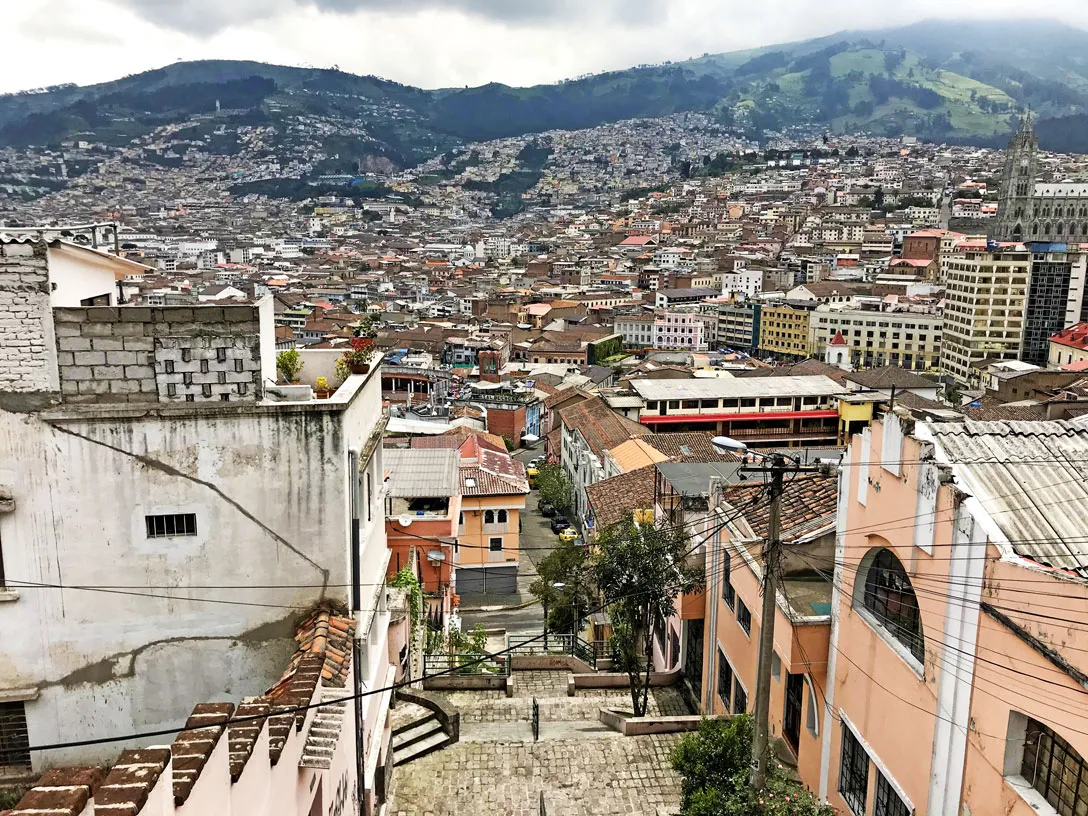
So many stairs in Quito!
Weather
April is not the best period to go to Quito, as it’s the last month of the rainy season. I discovered that the weather here is quite predictable: sun in the morning and rain in the afternoon. Every day.
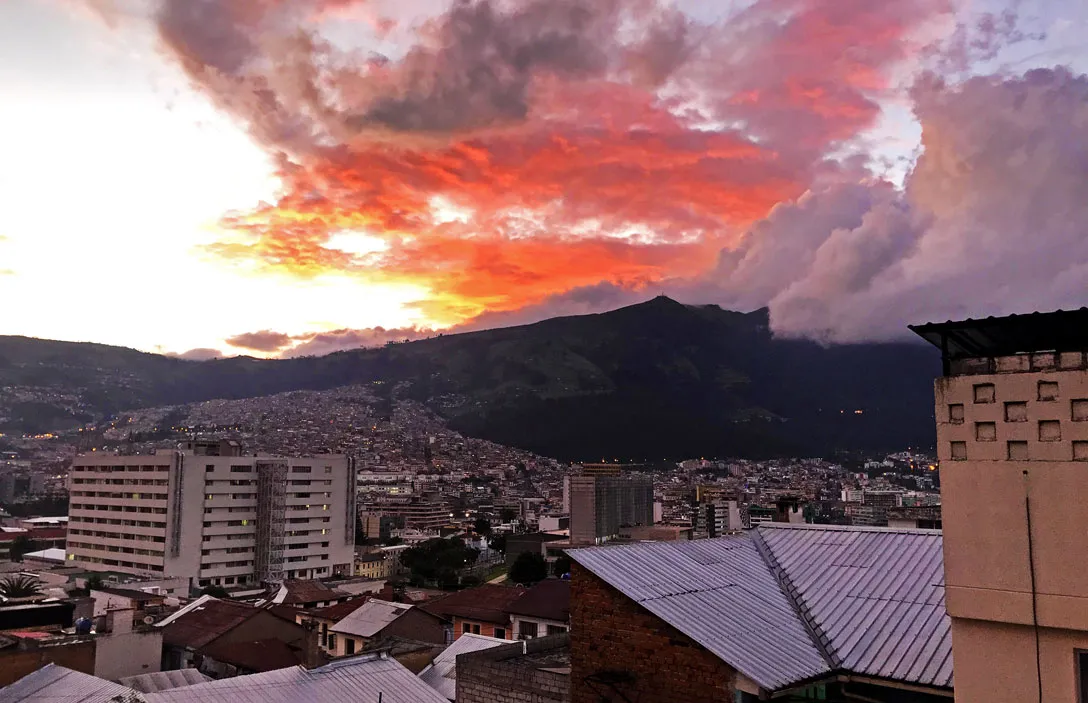
A nice sunset in Quito (photo by Maddie Rutherford)
When it’s sunny, it’s hot and you can get burnt in 15 minutes (don’t forget sunscreen!). When it rains, it doesn’t last for long, but it can be quite strong, even with hail. And usually after the storm the temperature drops.
So I used to wear a rain jacket during the day, even if it was sunny, as the weather can change suddenly. And a warmer jacket during the night, when it can be quite cold.
Transportation
Besides walking, there are three options if you want to get around the city: buses, taxies and Uber. The first one is the cheapest ($0.25 for a ride), but you have to watch out for your belongings and also learn to jump off and on the bus, as it doesn’t really stop.
Personally, I always took a taxi or an Uber, that are quite inexpensive: a ride in the city can cost around $2-3.
If you take a taxi, you have to be careful that it’s an authorized taxi: it should have the number on the side or front, the meter and an infrared camera inside. There are many stories about fake taxi drivers that kidnap people and mug them.
Moreover, most of the taxi drivers often try to scam tourists, not switching on the meter and asking for a huge amount at the end of the ride. So, just demand to switch it on or at least agree on an amount before leaving.
Anyway, whatever transportation you choose, it will be a thrilling race! Quitenians drive like crazy: they go through all the stops, honk the horn every second and don’t stop at the red light. Moreover, if you try to cross the road, there’s no chance that cars will stop to let you pass: you have to throw yourself into the traffic, hoping not to get hit. But I have never seen any accident: they are really good drivers and they have to! It’s just a matter of survival.
Food
Food can be very cheap in Ecuador. I used to have lunch in restaurants near the house that make the almuerzo: a daily menu that usually includes a soup, a second course, a juice and sometimes also a dessert. For $2.5!! It’s cheaper and quicker just eating outside than cooking by yourself.
The downside is that Ecuadorian cuisine is not really varied: what cannot fail in any Ecuadorian dish is rice, plantains, chicken and popcorn! Let’s say that after a month of this, I was looking forward to going to Peru.
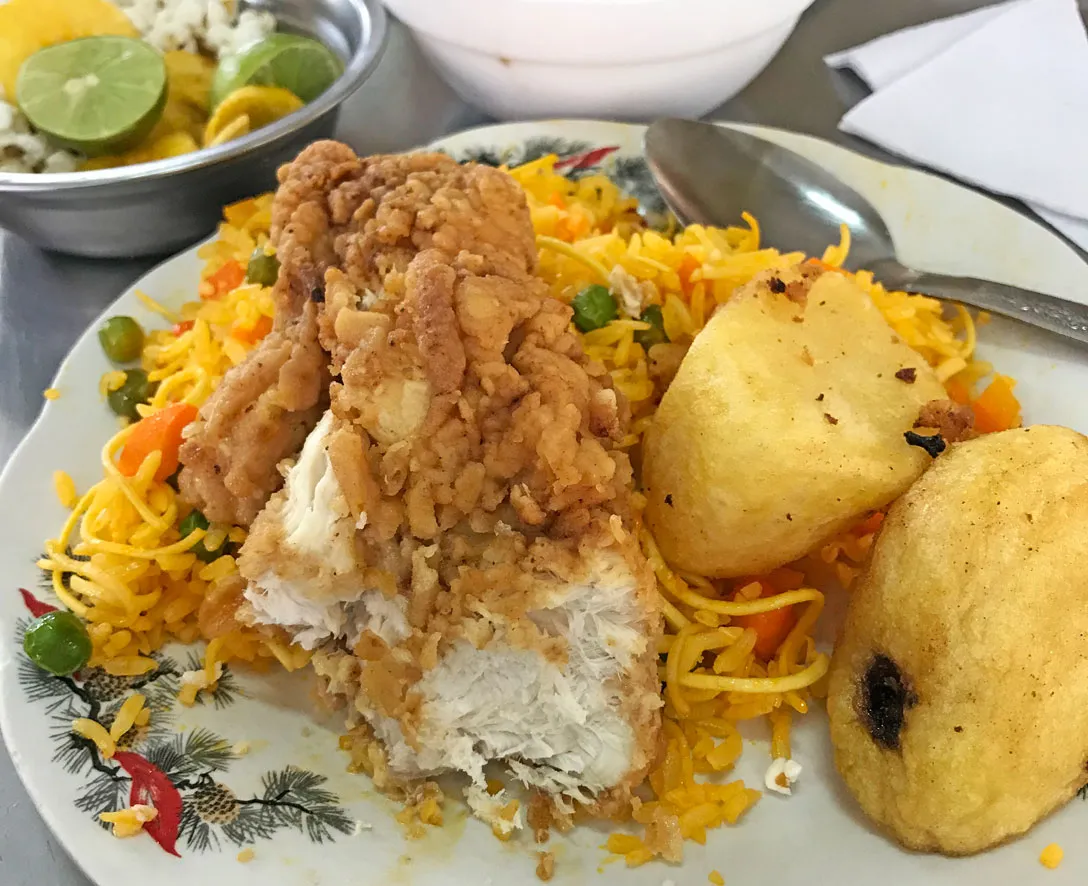
A corvina, served with popcorn and plantains
Of course, there are plenty of alternatives: the Mercado Central offers local dishes at cheap prices. You can have the classic churrasco (a dish with a thin cut of beef, topped with a crispy fried egg served with French fries, a small salad, avocado slices and— of course — plantains and rice), ceviche or the corvina, a tasty fried fish served with potatoes.
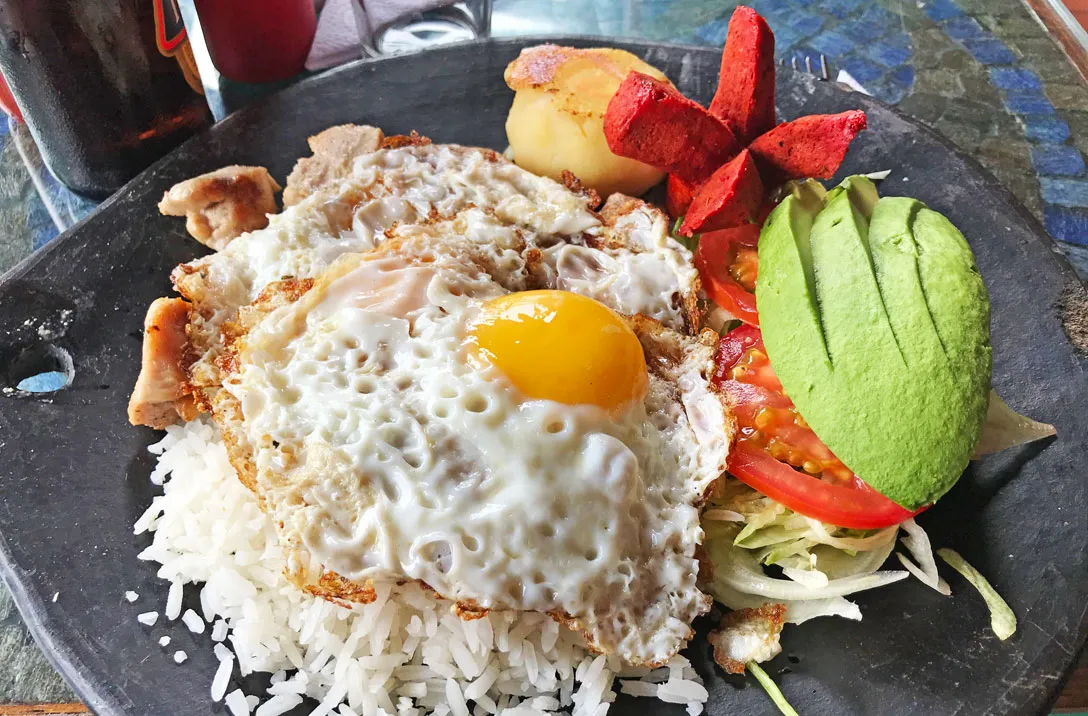
The typical Churrasco
In the same market, you can also find natural juices (jugo!) with blackberry, coconut or some local fruit as guanabana and naranjilla.
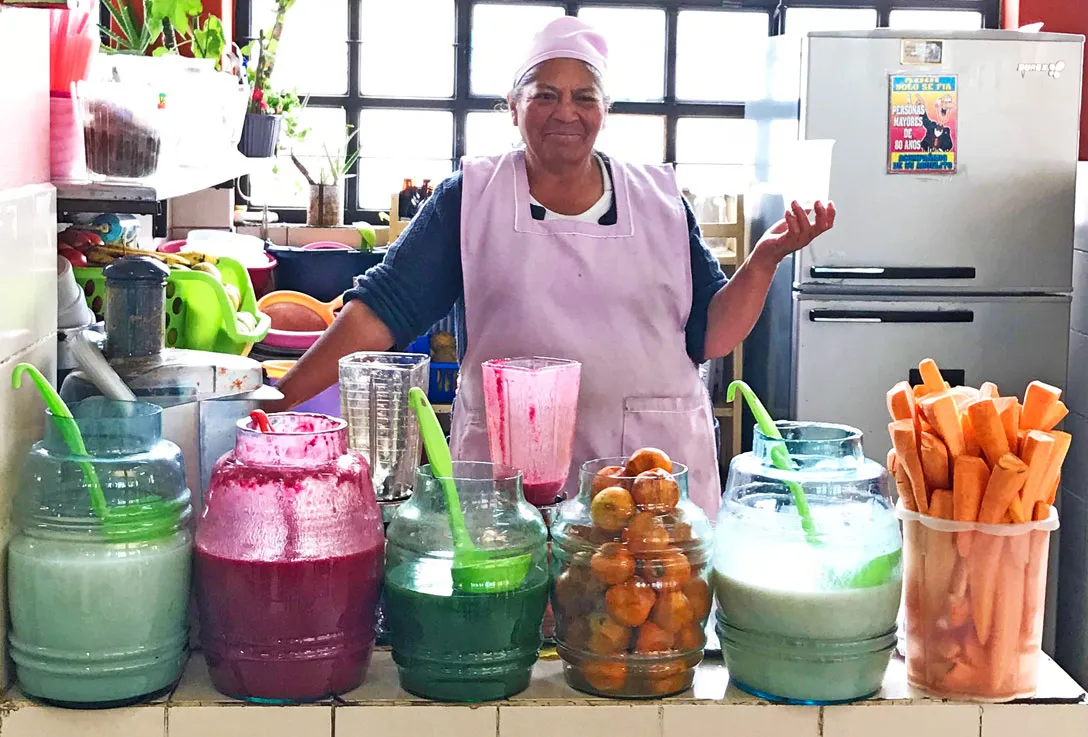
Choose the jugo you prefer! Mora or guanabana?
What’s important is that they made the juice with boiled filtered water. In fact, the main danger for the traveler in South America is tank water: you can’t drink it and you have to make sure to avoid everything made with it, also ice cubes. Our body is not used to that kind of bacteria and they can have unpleasant effects.
Ever heard about the Montezuma’s Revenge? Well, I have been very careful about what I eat and drink, always asking if boiled water was used, avoiding street food and unsafe places. But despite that, I got it: the first day I wasn’t able to get up from my bed, with high fever and the need for a bathroom every few minutes. The second day I felt better, but I have been sick for two entire weeks! I really have no idea what caused it, but it happened to me and to 4 other people of the Tribe. Maybe something we ate.
Besides street food, there are some restaurants in Quito that you really want to avoid. They seem very unofficial places and look more like a private kitchen directly on the street rather than a restaurant, with the stove and pots in plain sight at the front, exposed to the car’s fumes. Those are places where you’ll get sick for sure! It’s no accident that locals call them huecos (holes).
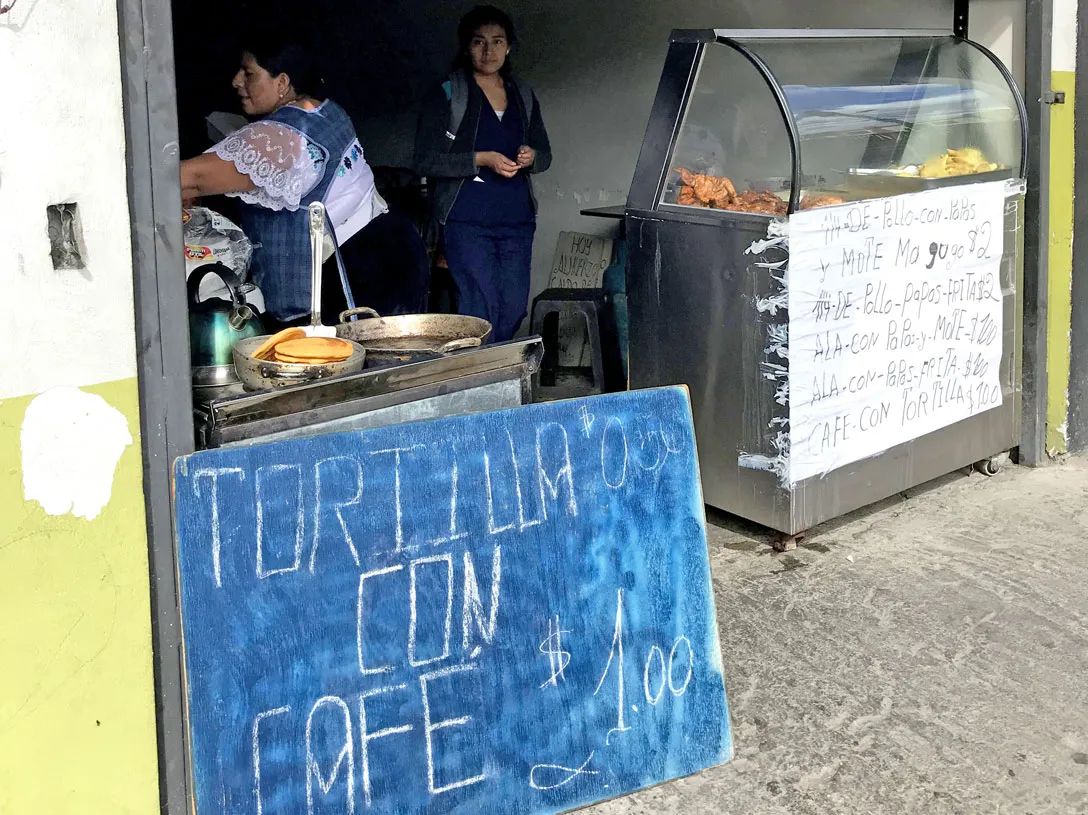
A nasty place you should avoid!
If you are brave enough, you can also try the ice cream sold by nice Ecuadorian girls in the historic center: they just stay at the door with an ice cream in their hand, trying to get your attention. But now the question is: why if you come back after one hour, they are still there with the same ice cream? Why doesn’t it melt??
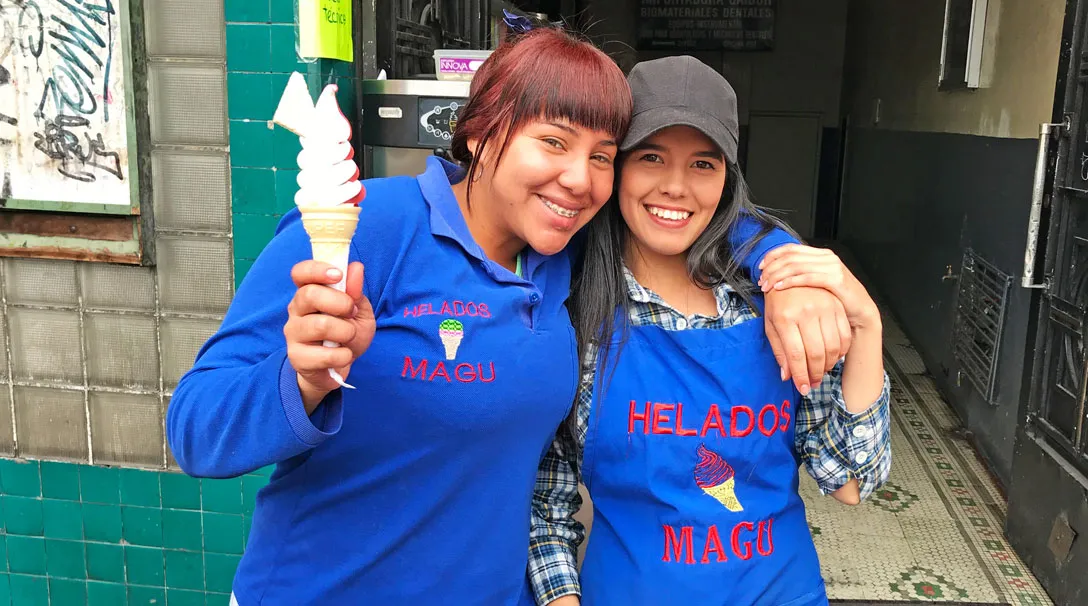
Making friends: the ice cream ladies!
A must to go bar-restaurant is Café Mosaico, where you can have a Pisco Sour, overlooking the entire city.
People
Ok, my picture of Quito is not very nice so far. But you know what I really liked? The people.
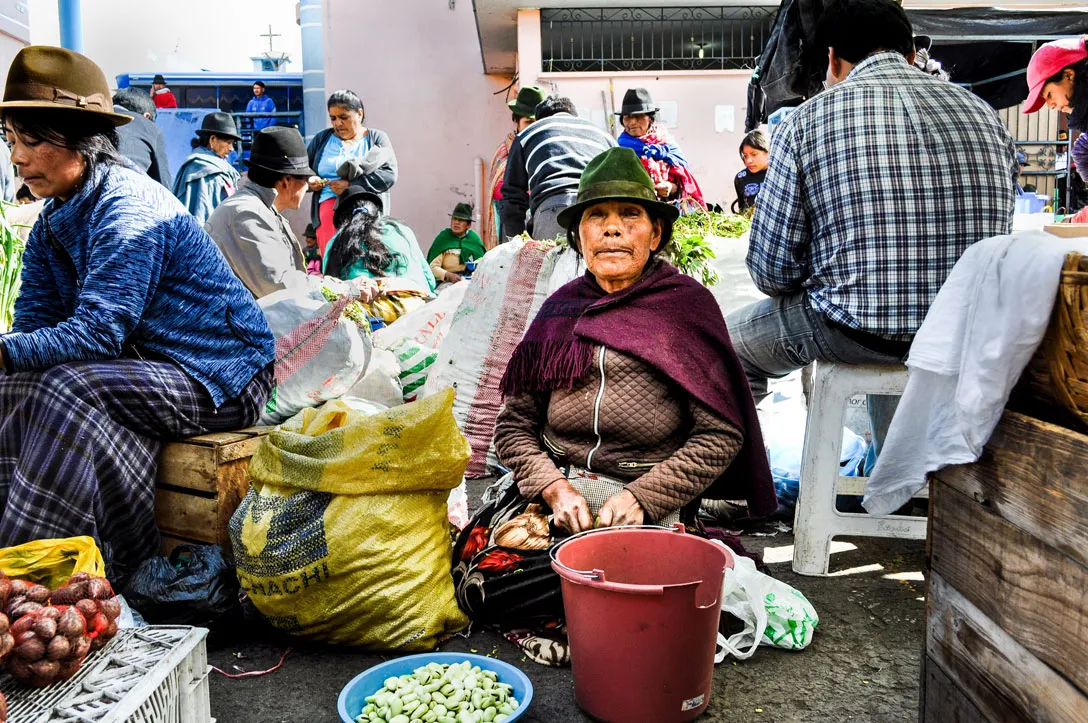
Local people at the Otavalo market (photo by Liz Borchert)
Quitenians are awesome! You just enter a chocolate shop and the owner can talk with you for hours, telling the history of cacao, the making of a Panama hat and recommending you the best places to visit.
Or you can get a taxi and meet a driver that is passionate about history, who will tell you everything about the El Dorado expedition, he will point out the most important buildings in the city, explaining which areas to avoid and why.

A shoes cleaner in the historic center of Quito
Or that other taxi driver, that will share his life with you, telling you about that time he tried to emigrate illegally to Spain and he got caught.
Or maybe you will meet a nice girl on a bus, on your way back from a trip, and you will talk with her for two hours, sharing different cultures and experiences. And after finding out that she has a girlfriend (yes, a girlfriend!), you will decide anyway to accept her invitation to have a beer. And you will try all the best breweries in Quito during the week, speaking about economics, politics and life.
Of course, if you want to get to know the culture deeply, you have to speak Spanish, as very few people speak English. But if you do, you’ll meet very nice, kind and welcoming people.
The language
In every Latin country, they speak Spanish with a different accent and with their own expressions. In Ecuador, the accent is not strong (at least for me) and it’s very easy to understand if you speak the Spanish from Spain.
What makes me smile is the interjection they use to say Ok. While in Spain they say Vale, everybody here says ¡Ajá! (which sounds like aha) and I find it very funny because they put so much emphasis on it.
In order to say Cool, people in Spain say Guay, but here you have to say Chévere or Bacán. As I’m used to say the first, it’s not easy to change it when speaking.
Of course, there are thousands of other expressions, but those are the most common I have heard.
What to see in Quito
As I said, Quito is a city full of culture and its old city center has many historic buildings from the colonization. With the free walking tour, you can visit the city center, learning about the history, economics and politics of Ecuador: knowing more about their crisis, about the reason why they switched to the Dollar as the official currency, about the El Dorado expedition…
The Basilica del Voto Nacional is also worth a visit. It’s an adventure climbing up to the main tower, as you will actually have to climb so many steep stairs and ladders in order to reach the top. But the view is worth it.
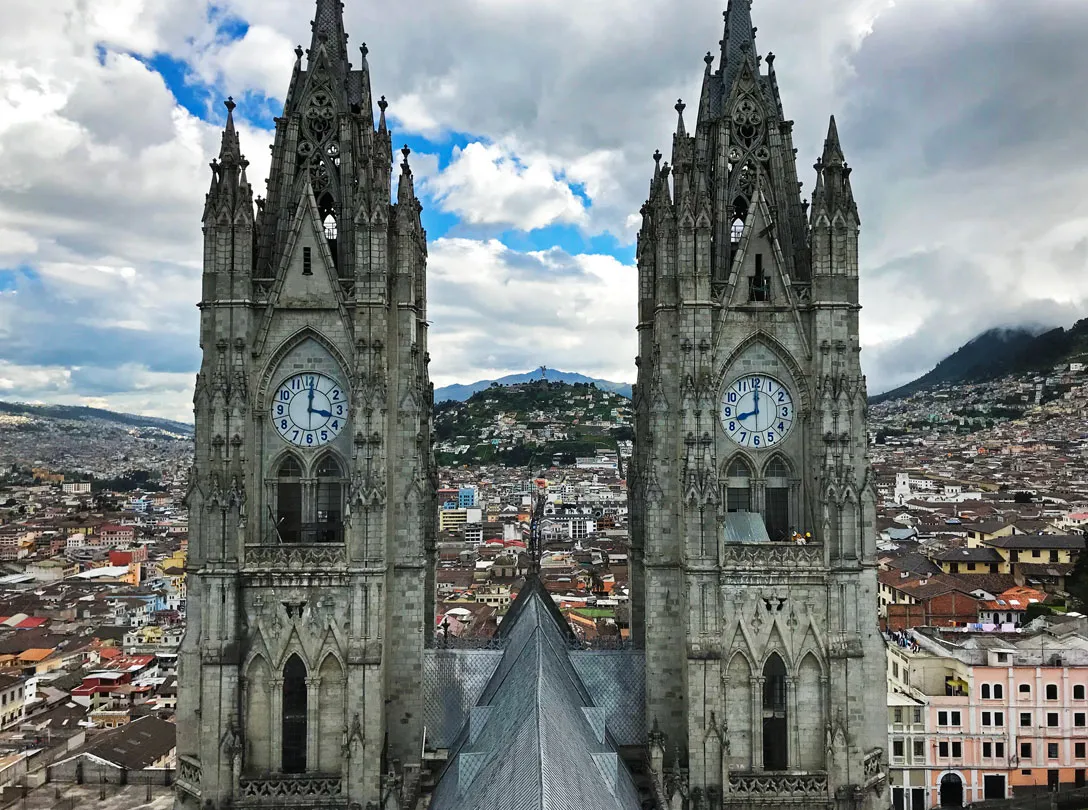
The view from the Basilica del Voto Nacional’s main tower
Speaking of views, El Panecillo is a hill that divides the north of the city from the south. You should reach it by taxi, as everybody recommends to avoid walking there because it’s one of the most dangerous areas. The nearby neighborhood was known to be the hookers one and, when the city expanded, all the pimps and drug dealers bought the apartments on that hill. But if you go by taxi, there are no problems as the top is safe and you will be welcomed by a giant statue of a winged Virgin Mary, and rewarded with a great view.
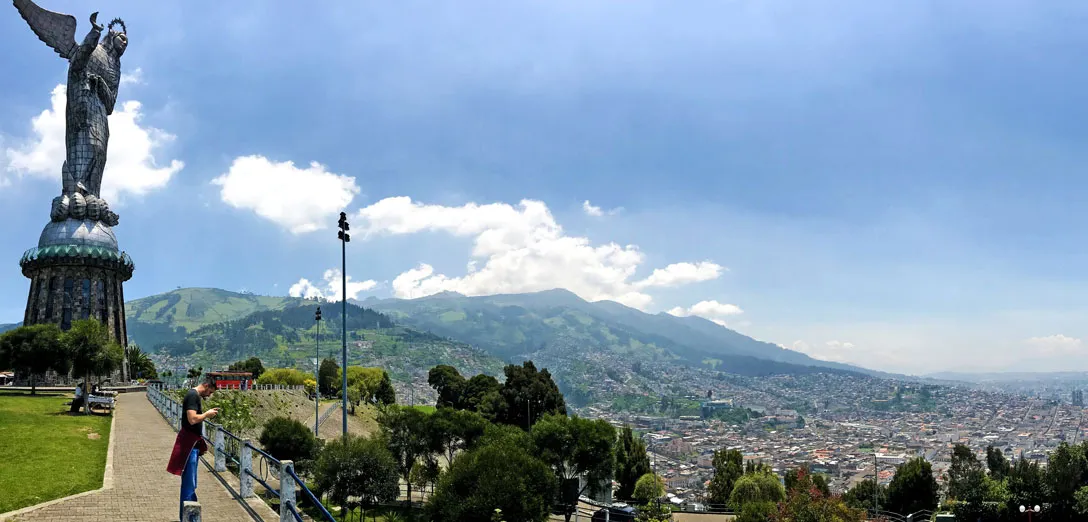
View from El Panecillo
At the bottom of the hill, you can relax in Calle La Ronda, the street of the artisans, where you can also find good food and Cannelazo, the famous alcoholic Ecuadorian drink made of cinnamon and naranjilla.
The must do, even if a little bit far from the city center (half an hour by car) is the _Ciudad Mitad del Mundo (_the Middle of the World City), where the line that divides the two hemispheres lies and it’s actually highlighted in yellow!
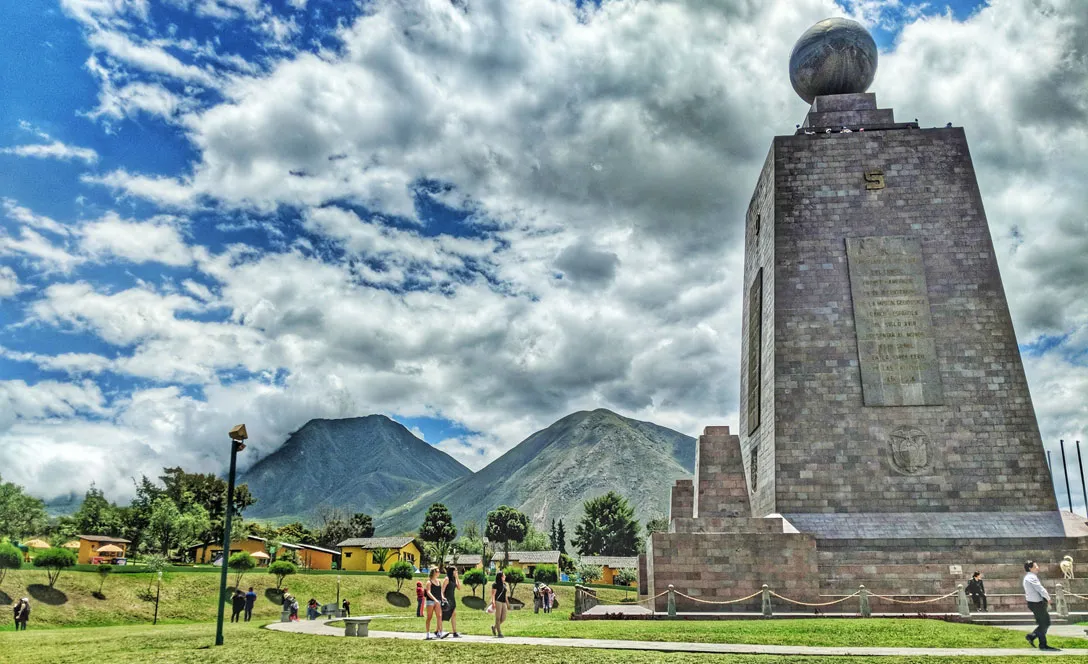
The monument at the Mitad del Mundo (photo by Brian Chek)
The truth is that this is not the real Equator: moderns GPS reveals that the real 0 is 240 meters more north, where there is the Intiñan Museum, a place with many demonstrations of tricks which are supposedly possible only on the Equator, such as water flowing both counter-clockwise and clockwise down a drain due to Coriolis effect, balancing eggs on end, or weakening of muscles due to latitude.
What to do outside Quito
The best moments of my month in Ecuador? Weekend trips, of course! Every weekend we went somewhere outside Quito, for 2-3 days, to visit the main attractions of the country.
The first weekend we climbed up the Cotopaxi Volcano, reaching 5,000 meters and running downhill by bike almost without using brakes. Crazy!

Hiking Cotopaxi with the Tribe!
The second weekend we went to Baños, a town 4 hours from Quito near the Amazon jungle. We spent the first day on a jungle trip, visiting an animal rescue center with monkeys and turtles, canoeing in the river, visiting an indigenous Kichwa village where they offered us Chicha (a handmade local drink), and we learned to use the cerbatana to throw poisoned arrows. Finally, we hiked into the jungle, where we swang like Tarzan on a vine above the cliff and we swam in a waterfall.

Canoeing in a river in the Amazon Jungle
The second day in Baños we hiked to the top of one of the mountains that surrounds the city and we reach La Casa del Arbol, a swing on a treehouse on the edge of the hill.
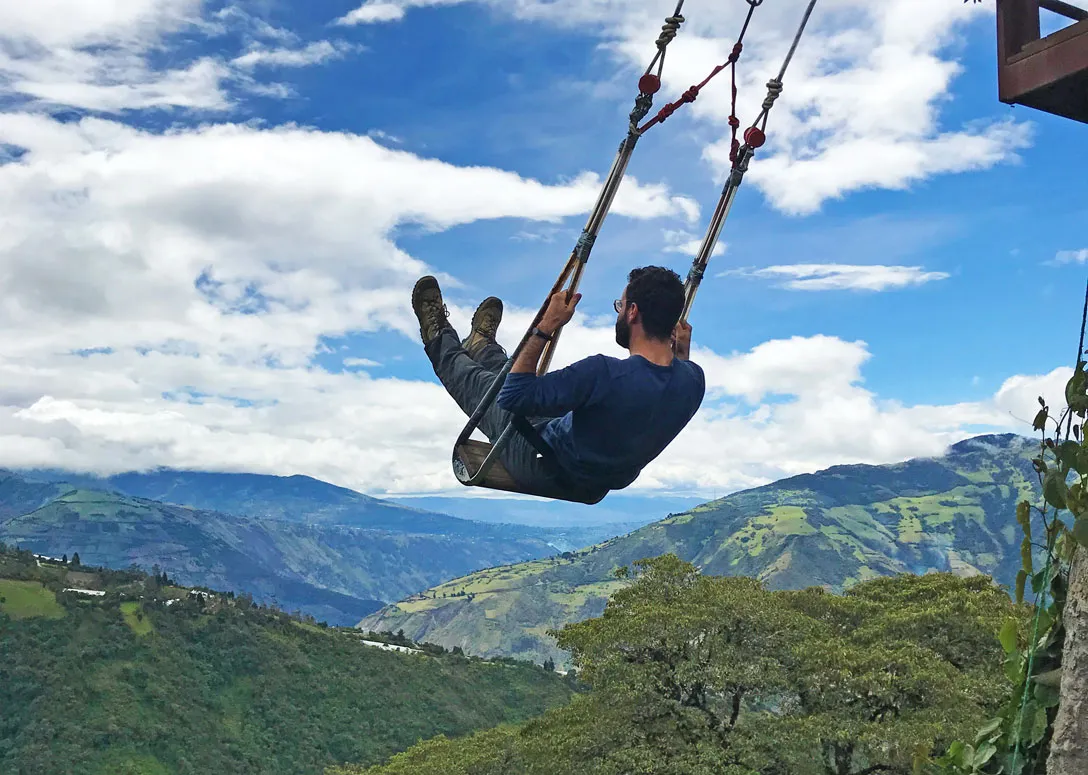
Swinging at the Casa del Arbol in Baños
The third weekend we went to Mindo, a very quiet town 3 hours from Quito in the cloud forest. There we did tubing down the river, we hiked in the forest among waterfalls, we visited a butterfly sanctuary, we did ziplining and we hiked into the forest by night, looking for animals and insects.
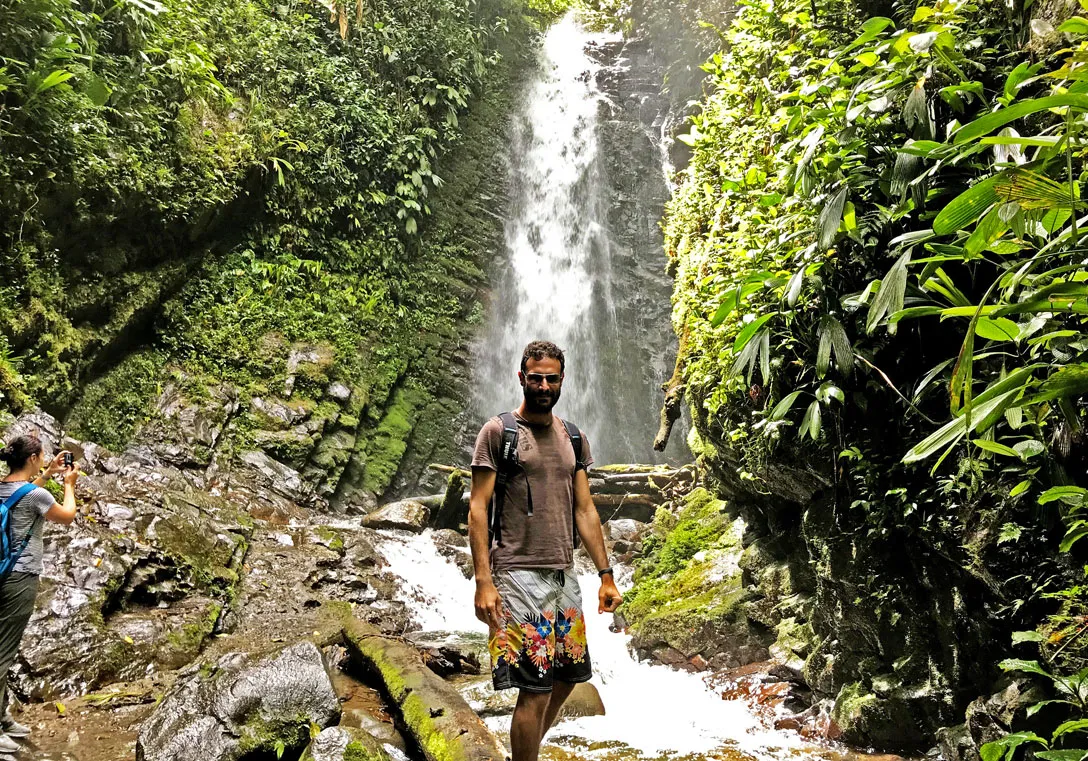
Hiking to the waterfalls in Mindo
The last weekend we went to Tena for a 5 days trip deep into the Amazon Jungle, but this is an experience worthing a post. And so does the Galapagos week!
How much have I spent?
I usually take note of every single cent I spend, so that I’m able to know exactly where I spend my money on.
Well, this is the breakdown of my month in Ecuador (excluding the Galapagos week):
- WifiTribe fee: $800
- Restaurants and drinks: $500
- Weekend trips: $500
- Taxi: $100
- SIM card: $25
- Groceries: $30
- Laundry: $10
If you add $450 for the flight from Europe to Quito, I have spent $2,400, which is not so bad, considering that I ate outside every day and I did a trip every weekend. Of course, if you go on your own, the rent will be way cheaper. And also if you go to the supermarket and cook yourself.
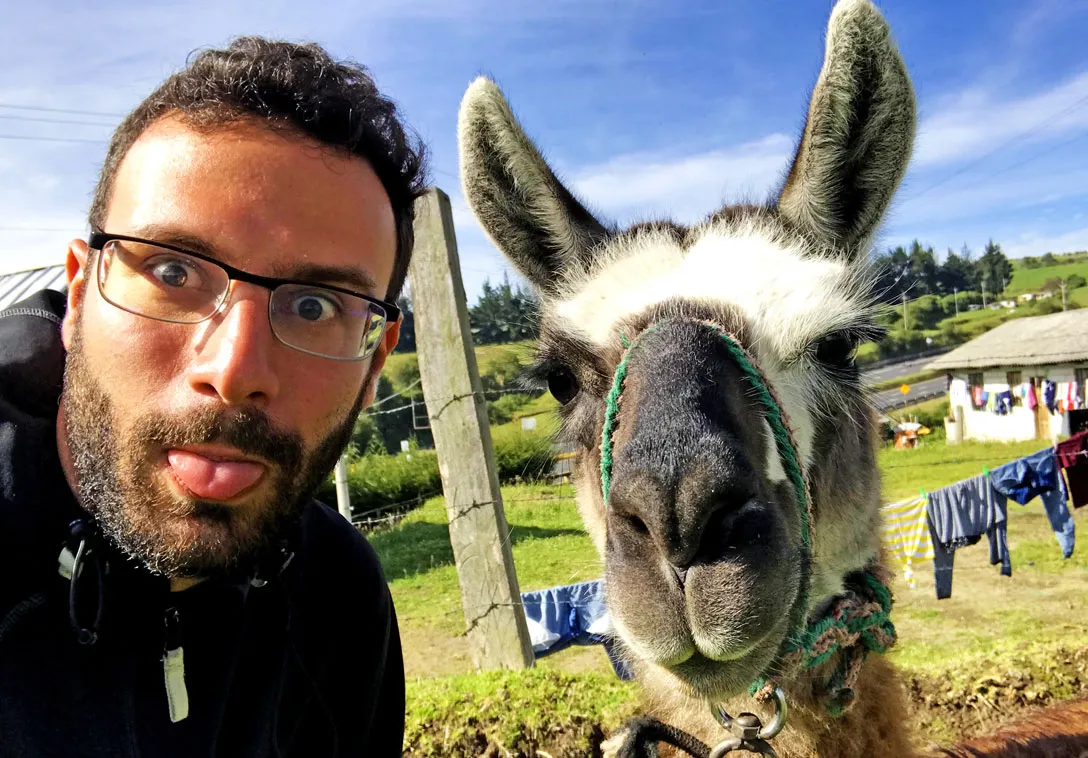
I can’t close the post without a Lama selfie!
Last thoughts
In conclusion, Ecuador is a place full of nature, adventures and wonders! I really recommend to visit it. Quito is the best strategic place where to stay, as it’s well connected to everywhere, but probably you are not gonna like it, especially if you plan to stay there for a month.
 Nomad Life
Nomad Life